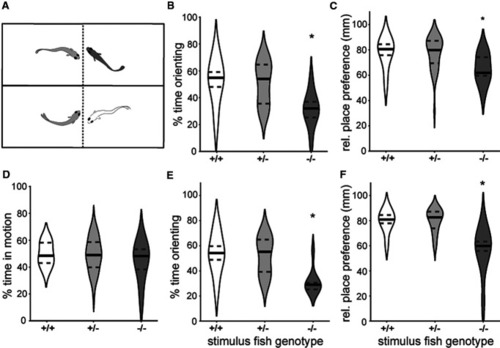
egr1 mutants are less social than wt larvae. A, Larvae from an incross of egr1sa64 were placed in roughly size-matched split dyads at 14 dpf and tested for social orienting and place preference, with the ability to see a sibling through glass. Genotypes [wt (white), het (gray), mut (dark gray)] were determined after testing. B, egr1 mutants spent less time orienting at angles between 45° and 90° to the divider. n = 56 animals, *p < 0.001 (mmANOVA). C, Relative place preference, as measured from the wall opposite the divider and normalized to the total length, revealed less social engagement for egr1 mutants. Zero denotes distance furthest from the divider. *p < 0.05 (HSD). D, There was no difference in overall activity measured as percent time in motion. Time orienting at angles between 45° and 90° (E) and relative place preference (F) for het and wt larvae based on the genotype of the stimulus larvae (stimulus fish genotype) revealed that a deficit in the mutants is detected by the het and wt larvae; *p < 0.001 (mmANOVA). Solid black line represents the median, dotted gray lines represent the upper and lower quartiles.
|